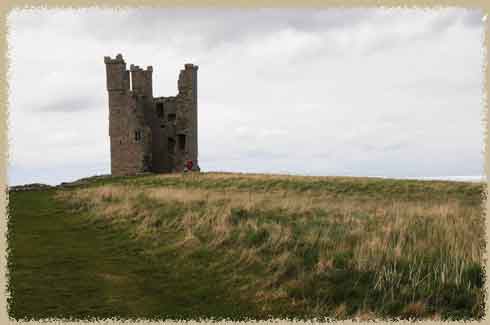Dunstanburgh Castle
When we set off, full of confidence to see the largest castle in Northumberland, we didn't realize that a) it was going to be so windy that we may have needed to carry weights to keep us grounded, and b) it was miles to the castle. We couldn't even see if until we'd been walking for 15 minutes or so. At that point, we were committed! It was so windy it was hard take pictures, so they are a bit sparse.

the enormous drum towers of the entrance to Dunstanburgh
14th century
SItuated on a 150 foot cliff into Embleton bay, this castle commands the headland near Craster, and after a long walk out to the castle site, it is a stupendous ruin, to be sure The castle encloses 11 acres inside a tall curtain wall. The south has two enormous drum towers at the wester corner, granting access to the castle. The opposite side of the castle courtyard has a large turreted watch-tower, called the Lilburn Tower.The remains date from teh 14th century.
The gatehouse is the most noticeable part of the castle, and they are of a huge scale. They are representative of the 14th century castle design. Each tower was originally four storeys (although both are quite ruined( and the towers would have had four turrets on each tower. The towers stand about 24m high.
The first floor of the towers were guard rooms and vaulted chambers to manage the portcullis which guarded the long passageway getween the two towers. Above, a hall spanned both towers. It is likely that private rooms were above this, but the towers are too ruined to tell. .

the lilburn tower
Two large square towers along the south wall were for private rooms. The towers, called the Constable Tower and Egyncleaugh Towers were comforatble living quartersm added later in the 14th century when the main gatehouse was closed up as a keep.. The large square Lilburn tower was also set up as a private residence, probably for the Earl Thomas of Dunstanburgh.
Ownership
The stone outcropping, surrounded by ditches and a long sloping approach from the landward side, was probably occupied in prehistoric times. However, in 1313, Earl Thomas of Lancaster (a cousin of Edward II) began construction of the large castle here. It was completed afer 1322. Despite the location of the caslte, it was not a player in the border wars against Scotland. John of Gaunt converted the twin-towered gatehouse into a keep.
The castle began to fall into ruin after 1464 and the War of the Roses, and it was reported in various states of decy throughout the 16th century. LIke many castles, it was mined for stones for local building.
The caste was owned by Sir Arthur Sutherland in 1929. He handed it over to state care at that time.

the castle covers the headland
and is entirely walled


